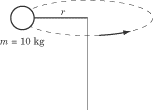Moment of inertia is a measure of an object’s resistance to changes to its rotation. It is the inertia of a rotating body with respect to its rotation.
For a point mass the moment of inertia is the mass times the square of perpendicular distance to the reference axis and can be expressed as:
l = mr2 (1)
where l = moment of inertia, m = mass, r distance between axis and rotation mass.
The point mass relationships are basis for all other moments of inertia since any object can be built up from a collection of point masses.
For rigid bodies with continuous distribution of adjacent particles, the formula is better expressed as an integral.
l = ∫r2dm (2b)
where dm = mass of an infinitesimally small part of the body
General Formula
l = kmr2 (5)
where k = inertial constant – depending on the shape of the body
SOME TYPICAL BODIES AND THEIR MOMENTS OF INERTIA
Inertia of Cylinder
Thin-walled hollow: comparable with the point mass (1) and can be expressed as:
l = mr2 (3a)
where m = mass of the hollow, r = distance between axis and the thin-walled hollow, ro = distance between axis and outside hollow.
Hollow: l = 1/2m (ri2 + ro2) (3b)
where m = mass of hollow, ri = distance between axis and inside hollow, ro = distance between axis and outside hollow
Solid: l = 1/2mr2 (3c)
where m = mass of cylinder, r = distance between and outside cylinder
Inertia of Sphere
Thin-walled hollow: l = 2/3mr2 (4a)
where m = mass, r = distance between axis and hollow
Solid: l = 2/5mr2 (4b)
where m = mass, r = radius
Rectangular Plane
Axis through center:
where a, b = short and long sides
Axis along edge:
Slender Rod
Axis through center:
where L = length of rod
Axis through end:































